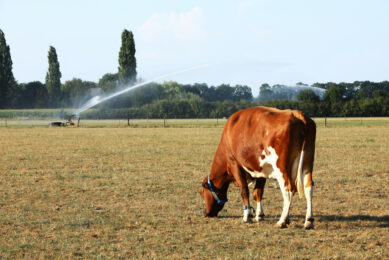Are you sure your cows are not experiencing heat stress?

With temperatures rising in many parts of the world, it is not only changes in the weather that is adding to the importance of cooling cows, but also the increasing productivity of the cows.
Thankfully we see more and more farmers taking action to keep their animals properly cooled, and with the changes in the climate we are experiencing worldwide, it is obvious that more cows need cooling.
Yield matters when it comes to heat stress
Why you might ask? It is basic physics, really. High-yielding cows consume a lot of feed that, of course, starts its journey in the digestive system of the cows in the rumen. Here, vast energy is released by the billions of microorganisms in the rumen and the cows need to get rid of this excess energy.
With higher outside temperatures it gets more difficult to get rid of the excess energy, so throughout the years, with better management and, at same time, increased productivity, also because of the impressive breeding programmes, we have actually moved the threshold for the cows’ most comfortable temperature downwards. You might say that cows today versus cows 50 years ago simply need more cooling now because of higher production.
Today, heat stress comes at a lower temperature
Therefore, 20°C today for a high-yielding cow is not the same as 20°C a few decades ago, simply because of increased production. And this also means that that same temperature and same humidity for dairy farm 1 and dairy farm 2 will not necessarily have the same impact on the cows on those 2 farms if the productivity is different between the farms.
Breeding for less heat stress in dairy cows
It is worth mentioning that there are some differences between breeds, so much points towards the possibility of breeding for high-producing cows that are more tolerant than the current average cow we have today. However, this will hardly solve the need for cow cooling, but might impact when we should start cooling them by a few degrees.
It is not only the temperature that matters in heat stress
Often, when we talk about heat stress in cows, the term THI is used. THI stands for Temperature Humidity Index and is a measure that has been used since the early 1990s. It accounts for the combined effects of environmental temperature and relative humidity and is a useful and easy way to assess the risk of heat stress. The thing is that you cannot only use the temperature as an indicator for risk of heat stress in cows because it also matters how humid or dry the air is.
If the air is humid, the cows cannot get rid of the energy by evaporation through sweat or by breathing in the same way as if the air is more dry. Therefore, is it harder for them to maintain an ideal body temperature if it is humid, even if the outside temperature is not that high. On that note, it is also worth mentioning that cows actually prefer temperatures below 20°C and that is much lower than the preferred temperature for humans. I think this is one of the main reasons that so many have not thought of this previously, simply because the ideal temperature and humidity for cows is quite far away from the ideal temperature and humidity humans want.
Signs to look for
If the cows cannot get rid of the excess energy they eat less to reduce the production of heat in their rumen and, as a result, we would expect the yield to decline. Other signs of heat stress can also be lower pregnancy rate. In fact, we can possibly call these symptoms “subclinical heat stress”, as those effects of the temperature and humidity on the cows are not clearly visual or obvious.
To make this example here more clear, we can talk about “clinical heat stress”. Probably the easiest indication for clinical sign of heat stress is increased breathing rate. Then other signs could be observation of many cows standing, increased water intake, more cows “hanging around” without doing anything and cows hanging around the water trough to name some clear signs of heat stress. The cows are basically uncomfortable, just like how we feel when it gets to hot or humid.
The solution?
With all that said, read the title of this again. If you are in doubt or even think the cows might be in the risk group of experiencing heat stress, then seek professional help in cow cooling. I would never just put up fans without having proper calculation of what is needed for the relevant farm, based on the need by the animals and the farm design. There are many solutions available and the right solution for one farm in one area might not be the right one for the next farm.
Join 13,000+ subscribers
Subscribe to our newsletter to stay updated about all the need-to-know content in the dairy sector, two times a week.










